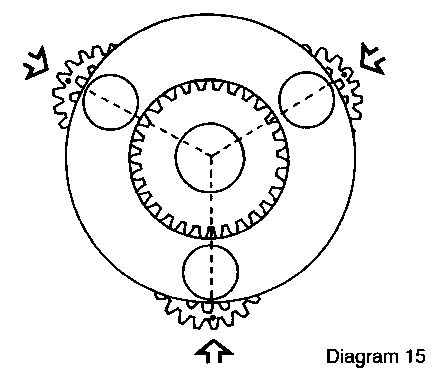Hi
I'm rebuilding an SA S5/2 alloy hub gear. I noticed the dire warnings in the SA instructions about making sure the timing marks on the planet pinions all point outwards. Having re-assembled with and without the correct timing (once I finally located the rather faint marks) I can tell the difference in smooth running but I'm intrigued as to why it makes such a difference.
Anyone care to elucidate?
Cheers
Stradageek
This might be a question for Brucey
Re: This might be a question for Brucey

the diagram is rather poor (it makes it look as if the smaller planet has an odd number of teeth; it doesn't) but the reason is that the smaller planet pinions are in mesh with the ring gear at the same time as the larger planets are in mesh with the smaller sun pinion.
Without the timing marks being aligned, the timing of the teeth onto the smaller sun pinion is unlikely to be correct.
You can see that the timing marks are positioned on a diametral line where a tooth on the inward side of the small planet lines up exactly with one tooth on the outer side of the larger planet pinion. (When this happens the converse is also true BTW). This alignment is not guaranteed otherwise because the small planet has 14 teeth and the larger step has 21 teeth; if (say) the small planet had 10 teeth and the larger one had 20 teeth, there would be no timing marks required; the timing would always be 'correct'.
one way of looking at this is that with (say) one stepped planet mistimed, the smaller sun pinion cannot sit exactly concentric within the larger planets; they won't necessarily all be timed in the same way. Not a very good explanation but the best I can do at the moment.
Planetary gears are pesky little blighters. The usual way with simple (single step, evenly spaced) suns is to have a ring gear tooth count and sun pinion tooth count that are both divisible by the number of planet gears. For example lots of SA gears have a 60T ring gear and in the (pre 2000) 4s/5s gears the sun pinions are 30T and 24T; both divisible by three. In the classic SA 3s hub there are four planet gears and the sun pinion is 20T; divisible by four.
However in the Sachs 3s hub the sun is 17T, the ring gear is 47T and there are three planet gears (15T). To make this work, the planet gears are unevenly spaced. I think they did this (with 17T and 47T being primes) so that all the teeth on each gear see all the other teeth on the mating gear; the same idea is used by some folk on motorcycle chain transmissions, the idea being that this way wear patterns won't develop in the sprockets/gears. To make this work then both sun and ring gear need to have a prime number tooth count. There may be a small theoretical benefit (provided the planet pin bushings are accurate) if the planet gears have an uneven number of teeth; the speed of the gears may be closer to constant. By contrast if the planet gear tooth count is even, the speed of the planet gears may be less constant, but there is less likely to be a net radial thrust on the planet gear at any one time.
hth
cheers
-------------------------------------------------------------------------------
~~~~~~~~~~~~~~~~~~~~~~Brucey~~~~~~~~~~~~~~~~~~~~~~~~
~~~~~~~~~~~~~~~~~~~~~~Brucey~~~~~~~~~~~~~~~~~~~~~~~~
-
Stradageek
- Posts: 1666
- Joined: 17 Jan 2011, 1:07pm
Re: This might be a question for Brucey
Got it! Many thanks as usual Brucey. You even answered the question I forgot to ask about whether this applied to the good old AW 3-speeds
Cheers
Stradageek
Cheers
Stradageek